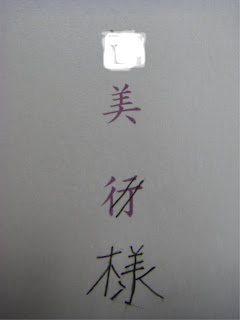I was so excited when I received a wedding invitation a couple weeks ago for my friend's wedding in Tokyo! It was a beautiful pamphlet style card with English and Japanese announcements and information. In the middle of the wedding announcement was the RSVP postcard, with a postage stamp already on it, and it was ready to be sent back to the couple.
Or so I thought.
For those of you who have recently received a Japanese style RSVP card, or expect to in the near future, maybe this blog entry will help you out. I had no idea what to do until I asked my Japanese co-workers.
When filling out your RSVP card, it is important to remember that Japanese are really into formalities, politeness, social hierarchy, respect, etc. I realize that this is a generalization, but this is generally the case for all written documents. If you forget to cross out something or add something, you could come across like a disrespectful, pompous jerk. Let's look at the RSVP card now:

1)
At the top, the two options are: "will attend" and "will not attend." As an expression of respect, an honorific, the phrases have "go" in front of it. So, the choices in Japanese are 御出席 (go-shusseki), will attend, and 御欠席 (go-kesseki), will be absent.
Because the "go" at the beginning is to hold respect and honor for you as the guest, you need to humble yourself and cross out this part for whichever you choose. Cross out 御. Then circle the desired choice. This shows the receiving party that you don't think the world of yourself.
Don't forget to strike through the other option. Make sure you do two straight lines through it!
I crossed out 御欠席.
2)
I'm not sure what you do for the next step if you don't want to go to the event, so I guess you'll have to go even if you didn't plan on it, because I can only teach you how to finish this RSVP card if you intend on attending.
Under the circled "will attend" kanji characters, write "will humbly receive" in Japanese. The phrase, "sasete itadakimasu," indicates that you appreciate the invitation and you are attending with this honor in mind. Sort of. According to one of the teachers here, it means "I'll do it," but in a way of lowering yourself in relation to the person reading it.
出席
させていただきます
3) You will need to cross out all phrases that include the word, "go."
So, not only do you need to cross it out in your RSVP response, but also in front of "name" and "address." It says, 御芳名 (go-houmei) and 御住所 (go-jyuusho), which means your name and your address. Go ahead and cross out that first kanji character before filling it out with your information. Then leave your message next to メッセージ. Even if you are very close friends with person or persons getting married, it is best to use formal language when composing your message.
4) Now, turn your card around. You aren't quite finished.
The RSVP reply requires language that humbles yourself. Now, you must use language to honor the person who receives the card. On my card, the name and address was already printed on. Be sure to include the kanji character for -sama (様), at the end of the receiver's name. This shows your respect to the receiver.

So, in the end it isn't so complicated. It's just important to remember to always humble yourself and put others above you. It makes the whole wedding process especially special. :)
Congrats to my buddy Jason on his engagement. Can't wait to see you in Tokyo for your wedding.
0 件のコメント:
コメントを投稿